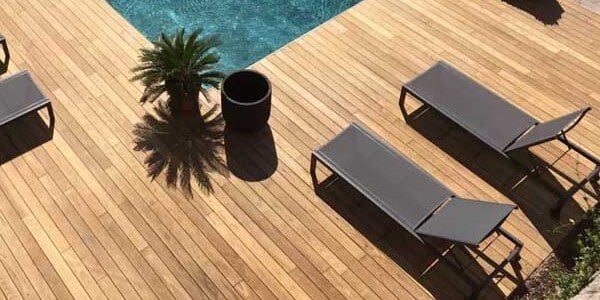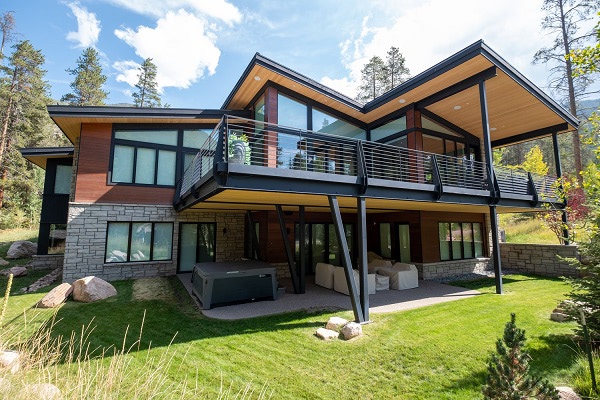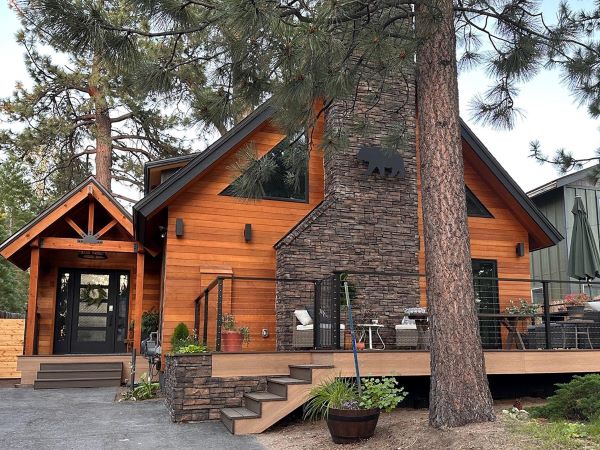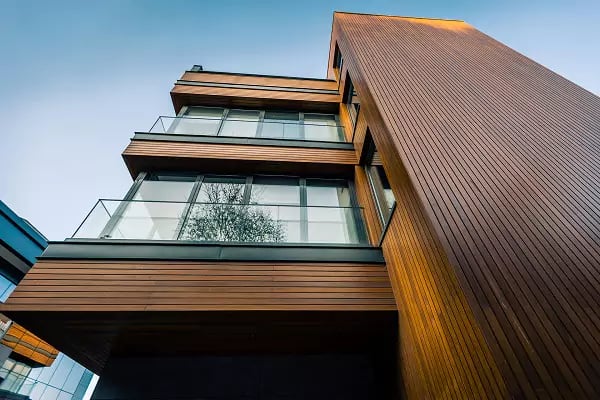
What is Thermally Modified Wood Decking and Siding?
Written by Chris Nolan onThermally modified wood has been making a name for itself among architects and home builders over the past two decades. This scientific process is used to stabilize standard wood so it will perform better than the original. Several thermal modification processes are available and many wood species have been tested. Some processes work better than others and different types of wood species perform differently than others. What should you know before you choose?

Mataverde ThermoWood, a modified Ash wood decking material, was chosen for this pool surround
Compare the differences of thermally modified wood to other types of wood decking, get a free copy of the "Ultimate Guide to Selecting The Right Decking". Download now!

ThermaWood Hem-Fir used to clad a home in ski country. When the best process is used, thermally modified wood can withstand all types of climates and adds a layer of insulation.
Unlike standard kiln drying, thermal modification uses super high temperatures to create a chemical change in the wood. The basic thermal modification process involves high heat in a specialized kiln that usually has no oxygen in it. The heat creates chemical and physical changes that alters the wood at the cellular level. Some amazing things happen to the wood during this process.
What happens to the wood when it is thermally modified?
These are the key changes that happen to the lumber during the process that make it an improved building material.
 Thermally Modified Hemlock adds real wood warmth by contrasting with stone, creating welcoming siding, soffits, entryways and overhangs
Thermally Modified Hemlock adds real wood warmth by contrasting with stone, creating welcoming siding, soffits, entryways and overhangs
Improved Stability
All woods expand and contract depending on their moisture content. If you add moisture to wood it will expand. As wood dries out it sheds moisture and shrinks. Thermal modification reduces expansion and contraction significantly.
- The thermal modification process greatly minimizes the amount of expansion and contraction due to moisture, making the wood highly stable.
- Also, the thermal modification process helps “tame” the wood, making it a lot less likely to warp, twist, bend or cup.
- The wood becomes harder, and significantly more durable.
Thermal modification darkens the original wood colors and helps blend out a lot of the original color variations. This creates a rich and handsome look for the whole project. The colors can be enhanced further with oil-based paint or stain. Another option is to allow the wood to silver out to a mellow gray patina.
 The natural heat-darkened color range of thermally modified hemlock, shown with a oil based finish
The natural heat-darkened color range of thermally modified hemlock, shown with a oil based finish
RELATED: View the Thermally Modified Wood Siding Project Gallery and Decking Project Gallery
Improved Decay Resistance
The natural acids and sugars in the wood are essentially “cooked out” of the wood during the process. This removes the food source for bacteria, fungi and insects - making it undesirable to them. The new thermally modified wood is now both rot and decay resistant.
Insulation Value
Wood is a very good insulator. Because of the changes to the wood cells, thermally modified wood is even better. Testing shows that thermally modifying wood can improve up to 20% or better insulation properties.
If you install thermally modified wood siding in a rainscreen system, you can expect better insulation values of your wall assembly.
Water Resistance
During thermal modification, chemical and physical changes to the cell walls of the wood occur. As a result, the wood becomes hydrophobic (water resistant).
Choosing wood siding and wondering what's best for your project? Check out the free "Ultimate Guide to Wood Rainscreen Siding" for answers, download here!

ThermaWood FR Hem-Fir shows off a light stained finish on this custom home
What are the best thermal modification methods?
There are three basic thermal modification methods: high heat only; high heat and steam, lower heat under pressure. Let's break down the pros and cons.
High heat only method:
Pros: The high temperatures ‘cooks out’ the acids and sugars, and the thermally modified wood becomes harder than the original wood.
Cons: The biggest downside is the wood itself becomes weaker, a lot more brittle, and has lots of checks, cracks, and splits. Up to 30% or more of the original wood can be lost during the process and must be defect cut to be usable as a siding or decking material.
Conclusion: Since the high heat is the most damaging to the wood, with the highest loss of material and a weaker end product, it is the least effective thermal modification process.
High heat and steam method:
Pros: Thermal modification processes using heat and steam do a better job of limiting the damage to the wood. The modified wood becomes more stable, darker, and more resistant to rot. Higher temperatures are required for exterior wood, such as siding or decking material.
Cons: The resulting wood is still more brittle than the original. Expect more than 20% of the original wood to be lost due to checking, splitting, cracking, and defect cutting into usable lengths.
Conclusion: While this process makes a stronger modified lumber, the brittleness and defects caused in the end product make this the the second-best thermal modification process.
RELATED: Read more technical information, research, and test data about the high heat and steam method
Medium heat under pressure method:
Pros: This process uses lower temperatures under pressure in a vacuum kiln. Because this process is achieved at without high heat, there is much less damage to the wood. Testing proves that the wood becomes slightly less brittle than the original with this process. The wood does not show lots of checking, splitting, or cracks after this type of modification.
Cons: 20% wood loss is expected during this process, but without heavy checking, splitting and cracks. The modified wood is exceptionally strong, with better working properties than the original, unmodified wood and other thermal modification methods.
Conclusion: This is considered the best and most efficient thermal modification process since it yields a less brittle, more stable, and very resilient thermally modified end product with a low loss of material and defects. This method is the least damaging to the wood and gives it results in all the benefits of thermal modification.
 Thermally Modified Hemlock wood leaving the vacuum kiln
Thermally Modified Hemlock wood leaving the vacuum kiln
What are the best thermally modified wood types?
The original goal of testing thermal modification was to figure out a way to make lower value woods and poorer performing wood species better than the original wood. This goal has been achieved. There has been some success in thermally modifying spruce, pine, fir, oak and ash.
-
Lower cost softwood species like pine and spruce will behave better after thermally modified than the original. By comparison, though, they do not have the same properties, durability, or strength as modified exterior hardwoods.
-
Poplar is a readily available hardwood and it thermally modifies well. Although it is not as strong as other hardwoods, poplar becomes a better version of itself when thermally modified. It works very well for exterior trim.
-
Ash is another native North American wood species that takes well to thermal modification. It darkens color nicely and performs well outdoors. The concerns with thermally modified Ash wood are mostly due to its availability, cost and lengths. Expect shorter lengths with thermally modified ash. Mataverde ThermoWood Ash decking and ThermoWood Ash siding are two great examples of quality modified Ash.
-
Red Oak has similar looks to Ash and is available in longer lengths. Unfortunately, early testing of thermally modifying Red Oak as a replacement for Ash has not yielded good results.
-
Western Hemlock and Hem-Fir have been thermally modified and thoroughly tested with excellent results. Although Western Hemlock is a softwood, it performs like a hardwood when modified. It even looks like the upper grades of gorgeous Western Red Cedar with a similar color and clear vertical grain.
 ThermaWood thermally modified wood siding graces the exterior of this home including the soffits and balcony overhang
ThermaWood thermally modified wood siding graces the exterior of this home including the soffits and balcony overhang
Mataverde ThermaWood Hem-Fir is thermally modified using the lower heat under pressure method, so you can expect excellent performance. ThermaWood Siding and ThermaWood Decking
See just how well thermally modified hemlock beats western red cedar in every comparable performance measurement. The chart below shows research compiled from the USDA Forest Products Laboratory, University of Minnesota and the University of Idaho research studies:

Comparison Chart: Thermally Modified Hemlock vs Western Red Cedar
DOWNLOAD COMPARISON CHART HERE
Fire-Retardant Treated Thermally Modified Wood

Homeowners in Tahoe, CA renovated their home exterior with ThermaWood FR Hem-Fir for the beautiful natural colors and fire-retardant treated benefits approved in their fire zone.
If you live, or are building, in a high fire zone there is an excellent, ignition-resistant wood decking or siding option. ThermaWood FR is a thermally modified Western Hemlock that has been impregnated with a long lasting, non-toxic, fire-retardant treatment. ThermaWood FR Hem-Fir is IWUI and WUI zone approved. The wood looks beautiful, and the Thermex-FR fire retardant treatment is permanent.
ThermaWood FR Hem-Fir is an innovative and versatile fire-retardant treated wood siding. Get inspired with a free copy of the "ThermaWood FR Hem-Fir Project Portfolio", download now:
We hope this article answered your questions about choosing thermally modified exterior wood for your next project. If you have any questions or need more information, please contact us, we are happy to help.

Related Posts




